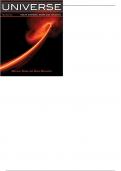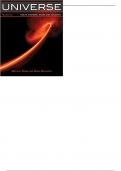Stars and galaxies - Study guides, Class notes & Summaries
Looking for the best study guides, study notes and summaries about Stars and galaxies? On this page you'll find 317 study documents about Stars and galaxies.
Page 2 out of 317 results
Sort by

-
Stars and Galaxies 9th Edition by Seeds - Test Bank
- Exam (elaborations) • 479 pages • 2023
-
- $24.99
- + learn more
Chapter_03_Moon_Phases_and_Eclipses 1 The Moon moves slowly against the background of the constellations. True False 2 Any location on the Moon is sunlit for three weeks and is in darkness for one week as the Moon rotates. True False 3 In most months, there are no eclipses. True False 4 As the illuminated part of the Moon grows larger from new to full, it is said to "wane". True False 5 Our calendar divides the year into 30day periods in recognition...
Complete Test Bank (with Questions Answers)
Complete Test Bank (with Questions Answers)
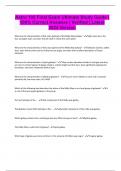
-
Astro 102 Final Exam Ultimate Study Guide | 100% Correct Answers | Verified | Latest 2024 Version
- Exam (elaborations) • 26 pages • 2024
- Available in package deal
-
- $13.49
- + learn more
What are the characteristics of disk stars (yellow) of the Milky Way Galaxy? - High mass stars, the Sun, youngest stars, and stars that all orbit in nearly the same plane What are the characteristics of halo stars (green) of the Milky Way Galaxy? - Globular clusters, oldest stars, stars whose orbits can be inclined at any angle, and stars with smallest abundance of heavy elements. What are the characteristics of spiral galaxies? - They contain abundant clouds of cool gas and dust, are rare...
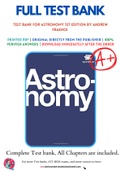
-
Test Bank For Astronomy 1st Edition by Andrew Fraknoi 9781938168284 Chapter 1-30 Complete Guide.
- Exam (elaborations) • 263 pages • 2022
-
- $23.98
- 1x sold
- + learn more
Test Bank For Astronomy 1st Edition by Andrew Fraknoi 8284, 3 Chapter 1: Science and the Universe: A Brief Tour Chapter 2: Observing the Sky: The Birth of Astronomy Chapter 3: Orbits and Gravity Chapter 4: Earth, Moon, and Sky Chapter 5: Radiation and Spectra Chapter 6: Astronomical Instruments Chapter 7: Other Worlds: An Introduction to the Solar System Chapter 8: Earth as a Planet Chapter 9: Cratered Worlds: The Moon and Mercury Chapter 10: Earthlike Planets: Venu...
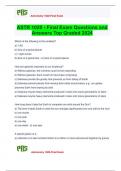
-
ASTR 1020 - Final Exam Questions and Answers Top Graded 2024
- Exam (elaborations) • 28 pages • 2024
-
- $14.99
- + learn more
Which of the following is the smallest? a) 1 AU b) Size of a typical planet c) 1 light-month d) Size of a typical star - b) Size of a typical planet How are galaxies important to our existence? a) Without galaxies, the universe could not be expanding b) Without galaxies, there could not have been a big bang c) Galaxies provide the gravity that prevents us from falling off Earth d) Galaxies prevent planets from leaving their orbits around stars; e.g., our galaxy prevents Earth from lea...
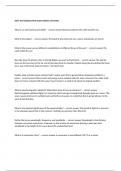
-
Stars And Galaxies final exam Indiana university questions and 100% correct answers
- Exam (elaborations) • 10 pages • 2023
-
- $11.39
- + learn more
What is an astronomical unit (AU)? - correct answer Distance between the earth and the sun What is the zodiac? - correct answer The band of sky where the sun, moon, and planets are found What is the reason we see different constellations at different times of the year? - correct answer The earth orbits the sun Describe how the pointer stars in the Big Dipper are used to find Polaris. - correct answer The pointer stars are the two stars at the far end of the bowl from the handle. Mot...
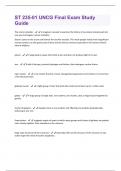
-
ST 235-01 UNCG Final Exam Study Guide Questions and Answers with complete solution
- Exam (elaborations) • 16 pages • 2024
- Available in package deal
-
- $9.69
- + learn more
The cosmic calendar - a imaginary concept to examine the history of our planet compressed into one year-Carl Sagan, human civilzation doesn't come on the scene until almost the last few seconds. This made people realize how insignificant human society is on the grand scale of time and the imense universe especially in the human-centerd view of religions. planet - A large body in space that orbits a star and does not produce light of its own star - A ball of hot gas, primarily hydrogen and...

-
ASTR final exam study questions and answers 2024
- Exam (elaborations) • 31 pages • 2024
-
- $15.49
- + learn more
Using the ideas discussed in the text, in what sense are we "star stuff"? - Nearly every atom from which we are made was once inside of a star When did humans learn that the Earth is not the center of the universe? - Within the past 500 years How are galaxies important to our existence? - Galaxies recycle material from one generation of stars to the next, and without this recycling we could not exist. If we imagine the history of the universe compressed into one year, dinosaurs walked...
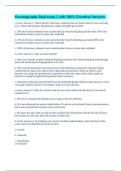
-
Oceanography final exam || with 100% Errorless Answers.
- Exam (elaborations) • 51 pages • 2024
- Available in package deal
-
- $15.99
- + learn more
c correct answers 1. Where did all of the heavy elements that are found inside of your own body (e.g., carbon and nitrogen, phosphorous, copper and gold) get created? a. 50% of the heavy elements were created directly from the Big Bang and the other 50% were created later inside of stars or when stars exploded. b. 10% of the heavy elements were created directly from the Big Bang and about 90% were created later inside of stars or when stars exploded. c. 100% of the heavy elements were c...

How much did you already spend on Stuvia? Imagine there are plenty more of you out there paying for study notes, but this time YOU are the seller. Ka-ching! Discover all about earning on Stuvia

